I thought we might get a breather episode, but nah.
Recap
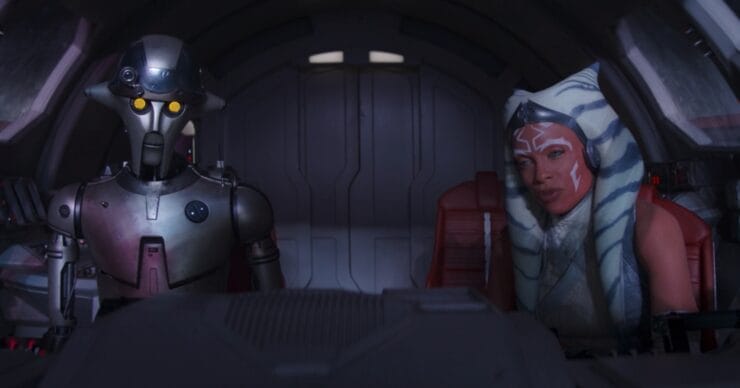
As Ahsoka and Huyang travel in the purgill’s mouth, she tells him the truth: That Sabine went with the enemy willingly. She laments not having the time to help Sabine make the right choice, but Huyang disputes that, believing that in the Force, perhaps Sabine made the only choice she could. Ahsoka asks Huyang to tell her one of the historical stories he told the younglings in the temple and he begins—
“A long time ago, in a galaxy far, far away…”
The Eye of Sion arrives in another galaxy at a planet known as Peridea—the original home of the Dathomiri. Elsbeth and company head down to the planet and meet the Great Mothers Klothow (Claudia Black), Aktropaw (Jeryl Prescott), and Lakesis (Jane Edwina Seymour), who are immediately suspicious of the Jedi element in their visitors’ midst that they did not foresee. They imprison Sabine below and call Thrawn to meet them. His Star Destroyer emerges over the Dathomiri temple, greatly altered in their time here, along with his troopers who have patched and revamped their armor. Grand Admiral Thrawn (Lars Mikkelsen) emerges, giving respect to the Great Mothers and speaking with Elsbeth. She tells him of their unexpected visitor, Sabine Wren, and Baylan Skoll explains that he made a promise to let her go search for her friend. Thrawn insists that the promise be kept and his Captain Enoch (Wes Chatham) sets her up with a mount called a howler and provisions, sending her off.
Thrawn then sends Skoll and his apprentice after Sabine, telling Elsbeth that the fact that the man was a Jedi means that they cannot fully trust him. They begin loading cargo from the temple onto the Star Destroyer in preparation for their journey home, planning to leave Baylan, Shin, and Sabine behind. Sabine runs into another native group in red armor, who attack her, but she fights them all off. Baylan and Shin later come across the site and discuss Baylan’s plans now that they’ve arrived at this place of Jedi legend; to his mind, the problem is that the defeat of the Jedi and rise of the Sith is merely a never-ending cycle, one that he means to stop. He also insists that he is training Shin to be something more than a Jedi.
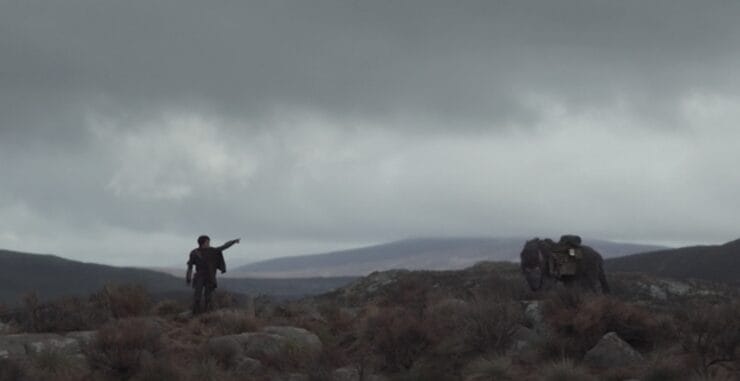
Sabine’s howler fled the scene when she fought, and when they reunite, she tells it off for leaving her and to go home. It follows her anyway, and its nose leads her to another species who live on Peridea called the Noti, one of whom recognizes Sabine’s Rebel Alliance symbol… and is wearing the original version of it, her rendering of the firebird. She asks if it knows where Ezra Bridger is, and a group of them lead her to their camp. There, she finally finds Ezra, who is grateful that she came to get him, as he knew she would. He wants more information on what’s happened in his absence, but Sabine isn’t ready to tell him everything yet—or what she did to get here. They pack up with the nomadic Noti and prepare to move camp. The Great Mothers sense that another Jedi is coming with the purgill, and Thrawn tells Elsbeth that this likely means Ahsoka Tano survived and that they should behave as such, preparing for a fight.
Commentary
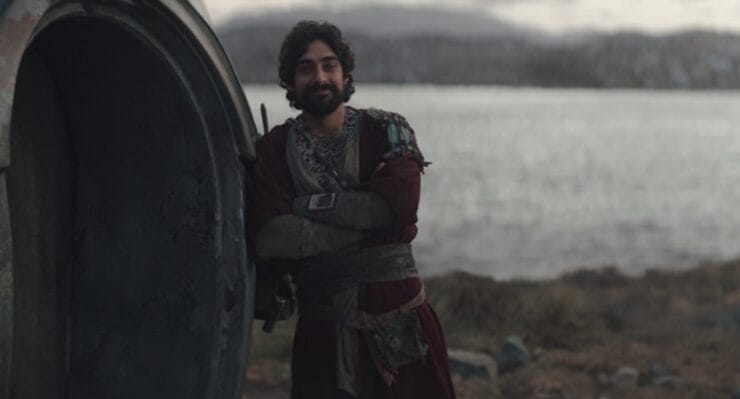
Gotta admit, I was unprepared for how emotional I was gonna get seeing Ezra Bridger.
Part of this is down to Eman Esfandi’s performance, which so instantly snaps into the impression left by his animated rendering that he comes off almost hyper-real: the trying-too-hard-to-be-blasé body language, the smirk, the immediate rejoinder of “Hey, it worked—didn’t it?” when Sabine points out that his plans (truly do) always suck. All the other performances we’ve been waiting on the actors to seep into their roles, to bring their signature attitudes and shimmer to live-action. But here, from the moment the camera finds him, your brain goes EZRA!! There you are where have you been young man what hour do you call this your mother Hera is worried about you and your father Kanan is so proud.
Buy the Book
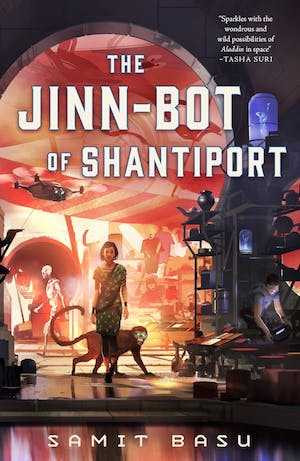

The Jinn Bot of Shantiport
It’s so good that he actually elevates Liu Bordizzo’s Sabine—together, they are entirely themselves. Having said that, this was a much stronger episode for Sabine overall, which was frankly down to letting the character loosen up and do what she’s best at: fighting like a Mandalorian and giving people a hard time.
I dunno, y’all, the last episode cleaved my heart in two, and now this episode might be the most Star Wars thing I’ve seen in years. It’s got everything—big capital V visuals, vibes on vibes on vibes, new aliens and creatures that are just combos of things you already love, high drama and high camp, deep emotions overlaid with hilariously minimalist dialogue. It was dragging a little at the start of the season, but the show’s hitting its stride now and it is giving.
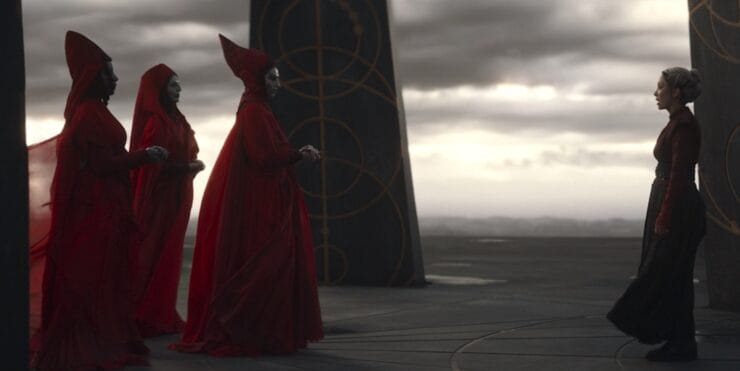
So it wasn’t truly made clear before that the Dathomiri came from this other galaxy, and that’s a big freaking deal. I’ve given a little background on their people previously, but this helps to make sense of a few oddities in their presentation on The Clone Wars, namely in their relationship to the Zabrak males on their world. The world that the Nightsisters were based on contained Zabrak men that they regularly controlled, enslaved, and offered up to other powerful galactic players. (This is where Darth Maul and his brother Savage Opress—do not @ me, that’s his real flipping name—came from.) It was always something of a mystery how/why this relationship emerged, given that the groups appeared to be different species, but now we can infer that when the Dathomiri first came to the galaxy, they decided to take over a world with the Zabrak on it and use them as they saw fit.
This is in keeping with their initial Legends appearance in The Courtship of Princess Leia, where the Dathomiri witches (who were not all dark side users) subjugated the men on their world as “husbands.” Yeah. It was a weird thing. The Clone Wars essentially revamped them to be a combination between Bene Gesserit and… vampires? Which has been real fun.
The Great Mothers are an example of something that Filoni does extremely well in Star Wars narratives (in keeping with Lucas’ entire oeuvre), taking our own real-world stories and myths, sticking them in a blender, and spitting them out in a mildly altered fashion to add texture. We’ve seen Dathomiri Mothers before, but these three seem to be the main crew in charge and they are modeled on the Three Fates (even using “threads” as a way of communicating their understanding of the Force and its patterns). I do wish they’d dig into what all this means, because the fact that the Dathomiri use the Force and come from an entirely different galaxy is kind of… momentous? Changes everything? And also, I would like to know why they hopped galaxies in the first place? If there are any of them left on Peridea at all?
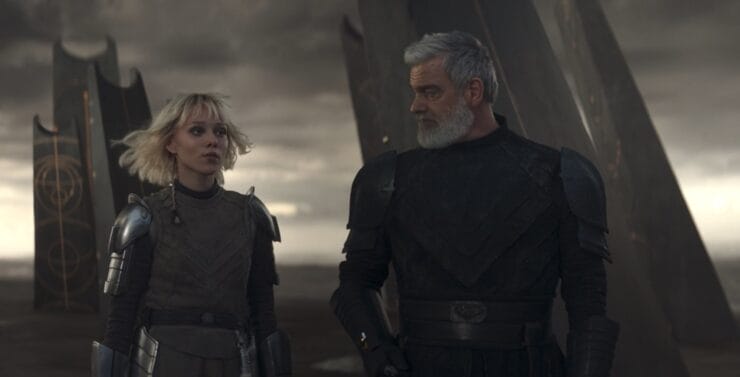
This is without getting into Baylan Skoll’s angst hour, in which he’s finally a little bit clearer about his point of upset and potential goals in all of this. It seems that he thinks that the cyclical nature of light and dark in the Force is a problem and possibly wants to… end all of it? Somehow? It’s a little weird to be getting a Wheel of Time argument in Star Wars, but I suppose it was inevitable at some point. The dynamic between Baylan and Shin is fascinating, but we need more of them, and I fear we won’t get it. (We’ve got two dang episodes left.) The Great Mothers perceive Jedi shenanigans in their midst when they zero in on Sabine at the start of the episode, but it’s him, I’m telling you. He’s the true wrench in every way that matters: He had his own plans going into all of this; he tells Elsbeth that Ahsoka is dead when he knows full-well that she’s likely not; he’s the one who brings Sabine here.
It’s pointed that only Thrawn immediately clocks the danger Skoll poses because that’s his whole thing—Grand Admiral Thrawn typically wins by never underestimating the tenacity and capability of his opponents. He lets his environment be grandiose for him while he sits back and observes quietly. (This is why he and Vader, uh, did not get along.) Speaking of which: That entrance.
Every Star Wars filmmaker wants to try their hand at the “Star Destroyer pans over the landscape and fills it with sheer enormity” opening shot because it’s the iconic thing, the moment in the very first film that Star Wars proved it would be something new to its audience. And while plenty of folks have done a real good job at aping that shot for fun, this is maybe the one time it was earned—and simultaneously showed up and showed out.
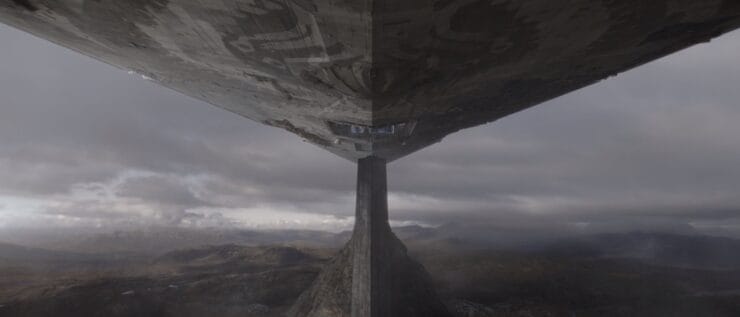
And do I love that we later see the extremely phallic temple run by a society of women positioned beneath the opening of Grand Admiral Thrawn’s Star Destroyer, as they proceed to, erm, load her up for the next step in their terrible plan? Uh, yeah. That was great. They did that.
But what’s better is that they juxtapose all of this extremely pregnant (stop me) imagery with the goofy stuff that Star Wars is made for. The fact that we take a break from the operatic action and machinations to watch Sabine yell at her bat-wolf-horse for abandoning her—and it pathetically choosing to follow her regardless—is primo storytelling. The fact that this then leads to hermit-crab-hobbit-brownies who can take her to Ezra is even better. Are the Noti and the red warrior folks essentially the Jawas and Sand People reskinned? They sure are. Does it matter? Not a whit. It’s time for silly problems (and not asking questions about why any of these people can even pretend to understand each other).
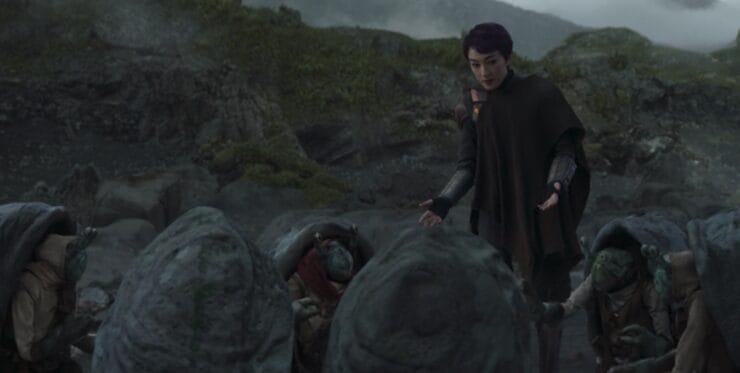
I also appreciate that we start the episode with Ahsoka insisting that Sabine made the wrong call, and Huyang immediately calling bullshit. Mostly I appreciate that Huyang is very firmly in Sabine’s corner because he is more ready to entertain her perspective and needs than Ahsoka is at this point. And that wisdom in turn reminds Ahsoka that she has more to learn, hence asking for a story. A story that begins with that familiar refrain…
…a story that I can’t believe they didn’t let us hear.
Bit and Asides
- I’m a huge fan of Farscape, which means that when the camera panned over the Great Mothers, I screamed aloud “That is Claudia fucking Black! Claudia! Look at you, girl, you look goooood in that witch getup.” I was way too excited to see her, particularly after it already felt like the episode had a Farscape shout-out earlier on—the purgill space graveyard is incredibly similar to both the Leviathan resting place and the budong corpses that we see on the series.
- Okay, but the mythology element here is pristine because Thrawn’s flagship is called the Chimaera, and now it’s effectively become one? Like, did Filoni know he was going to do this years ahead of time during Rebels? I need to know if this was always the plan or just excellent random happenstance. It’s too good.
- Campaign to fix Grand Admiral Thrawn’s hair in a special edition, that’s the one thing that’s off right now.
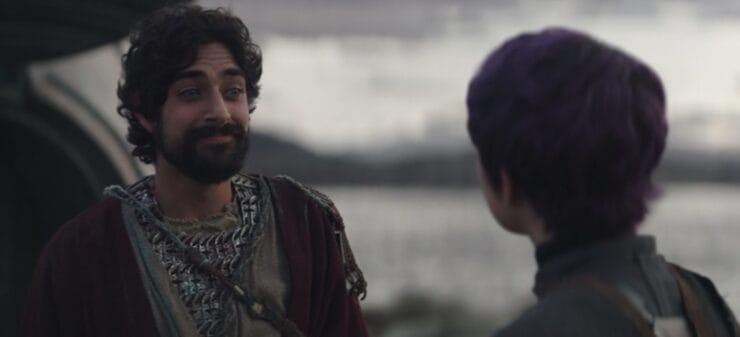
- Thrawn’s eyes are a little weird in the CGI, too, but it does lend him a properly uncanny vibe. I forgot that they were likely to alter Ezra’s eyes, but more bemused by the fact that they were determined to make them the exact shade of electric blue that the animation made them. The effect is jarring, but I kinda love it.
- The stormtrooper armor altered and mended with gold-sheen metal beats everything by a mile, just eat your heart out, First Order, you literally look like clowns by comparison. Though I do have some questions about Captain Enoch, namely whether or not that man saw Agent Kallus once and decided to build his entire identity on that, because there are some similarities…
- The symbol that the hermit crab buddy shows Sabine is the progenitor of the Rebel Alliance symbol, which was designed by Sabine herself and used as a graffiti tag that she often upended to the Ghost crew’s missions. It’s a firebird, which later became the namesake of Hera’s Phoenix Squadron (the emblem of which you can still see on General Syndulla’s jacket), and then morphed into the more recognizable symbol you see all over the Alliance.
Next week is the penultimate episode and I am not prepared.










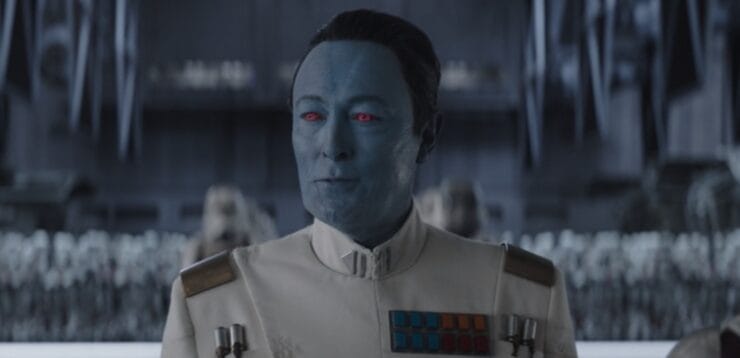
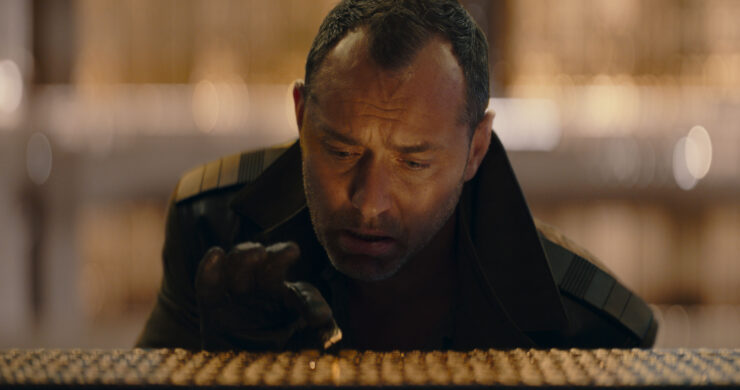
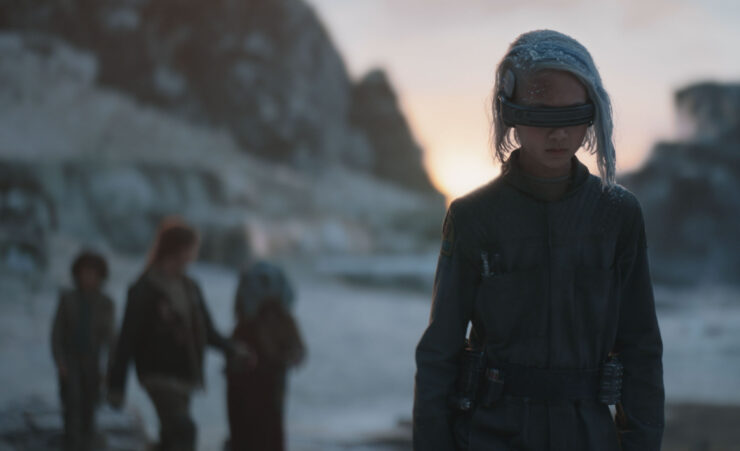
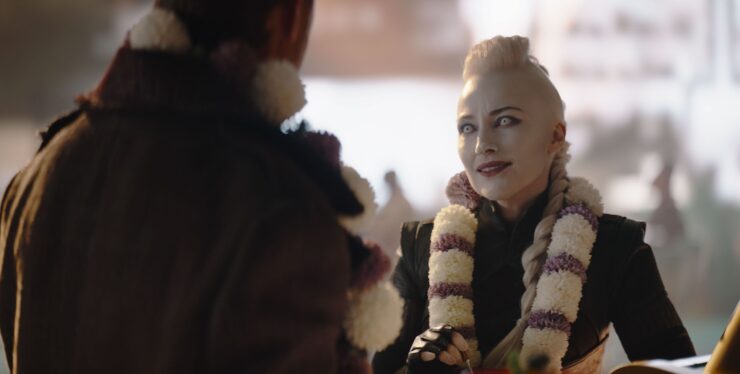
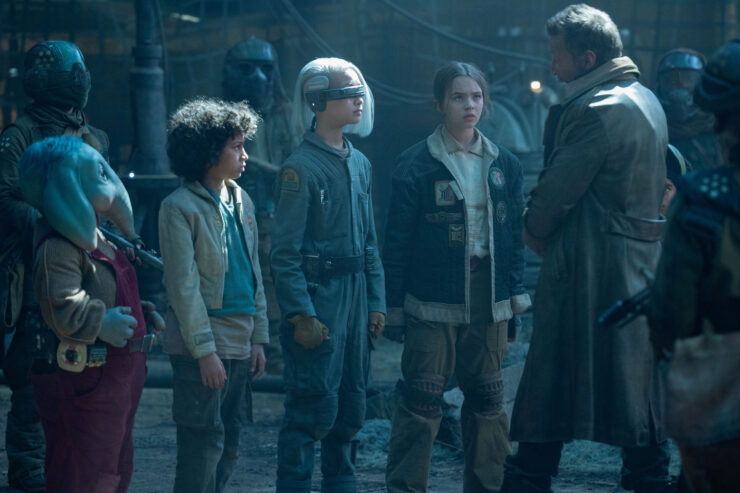
I’d almost forgotten about Miles’ little radioactive farmland stunt. To be honest I see a lot more resemblance to Cordelia in his planning at this stage of his life, since all his plans have been either “lie outrageously so that everyone will assume you’re going in the right direction and follow you,” or “make a simple plan, watch it go down in flames, and then improvise.”
The Oserans are a mess, and I have to say that Miles’ start in the fast-talking mercenary department was much easier on him than Mark’s was… even though he has no idea what he’s started, and hasn’t got a clue about Bothari or about ship warfare in general that might actually let him follow through on his intention not to kill any of their captives.
And as a call forward… Hi Bel!
It’s been awhile since I read this, is the pilot ever named? By Memory, Miles has forgotten his name, although not his murder. I wonder if that was Bujold lampshading the fact that the pilot was only there for the codes and for Bothari to be a monster and so she’d never bothered naming him.
LMB sets us a fiendishly clever ethical dilemma here. Opponents against torture usually argue that torture is ineffective. It would seem to follow that effective torture may be justified (you would think proponents of torture would agree that ineffective torture is unjustified, but that is not how humans usually think). Here we are presented with a convincing case of effective torture. Bothari knows exactly what he is doing – “pain is not the point”. Hopefully, this only works with jumpship pilots.
But Miles is not fighting for Light against the Dark side. He is a gunrunner and the Felicians may, for all he knows, be the local equivalent of the Islamic State. Financial desperation does not justify the use of torture. The saving grace may be the unprofessional behavior of Captain Auson. He behaves like a bandit, and bandits have few rights in a lawless region. He also comes close to kidnapping, and I set no limit to what a kidnap victim may do to the kidnappers. So, a knife-edge, but I vote for a passing grade.
Apprentice was my first intro to the Vorkosiverse, and the interrogation scene suddenly reminded me this wasn’t a ‘light’ book. I’ve always felt that until the very last second Miles doesn’t realise that his bodyguard is truly capable of torture: or at least such a irreparable one.
What happened to chapter 7?
Yes, this is the moment that Miles truly understands that Bothari is a monster. He’s been a rock for all of his life, a solid figure protecting him from the world. But Bothari changes based on the people around him. Aral made him a soldier, Vorrutyer made him a beast, Cordelia makes him a human. Miles … has yet to define him – up until now he hasn’t been adult enough to make an impression.
By acting as an interrogator, he makes Bothari act as a torturer. And that realisation sinks home – Bothari is his responsibility, if he unleashes the monster, the costs are on his head.
And then the unexpected yet inevitable death of the pilot brings all the consequences home. Miles will try and avoid unintentionally unleashing that sort of problem again in the future. It’s a short sharp shock to his system that has lasting consequences, and he very much grows up in that moment. I’ll keep that in mind, when I come to explain to my father how it was we happened to torture a prisoner to death”.
@5 ThSpeck – A minor snafu, last thread was really ch 5-7.
A minor note, in your 4th paragraph of commentary, you refer to Bothari as a “liegeman.”
“Liegeman” and “Armseman” are two distinct things, and women can take a “liegewoman” oath, but not an “Armsman” oath (at least until Mark…) Bothari would doubtless be quite offended to be called the lesser form of vassal.
@3 It’s probably when torture is most effective: wrong answers would be easy to check, the victim actually has the information, and the victim is in no way prepared to resist. Though I still want to see protagonists resort to torture and it doesn’t work. But not any protagonists I like.
I think this locks Miles’ forward momentum into overdrive. For all that he claims that the Dendarii were created for Elena or the Little Admiral, from this point on he has to create something worth dying for; something worth killing for. Otherwise he’s just a murderer.
Do we ever see Miles explain this to the Count-his-father? Because that would be awesome.
ETA: It’s interesting that we seem to accept Bothari’s lack of agency in this. We know he’s more comfortable “just following orders” but he still has a duty to refuse. Sure, his moral judgment is either non-existent or horrifyingly bad but there’s some pretty nasty implications in denying that he’s allowed to have any. One ought not to submit wholly to another’s moral decision in the same way one ought not to become a slave. One choice should not deny all future choices.
I’m a bit surprised that, as the adult that the child Miles spent the most time with, Bothari’s ruthlessness didn’t rub off on him in other ways. Or that Miles had never seen Bothari let loose on anyone before this – even if Bothari felt compelled to hold back with Piotr and teasing children as threats, when superstitious adults started acting up, I’m surprised that his true nature didn’t show more.
Bothari was practically a third parent, when Aral and Cordelia were busy with the demands of the Regency. Yet somehow, Miles seems unaware of the basic nature of Bothari’s personality. And he credits his values to Cordelia, Aral, and, to a lesser extent, Piotr. Not to the adult who was with him constantly.
It’s a bit odd.